 Private Richard Preston, 36299, Northumberland Fusiliers, 18th Battalion
Private Richard Preston, 36299, Northumberland Fusiliers, 18th Battalion
Richard Preston was born on the 25th February 1886 and his birth registered in the Dewsbury district. When he was baptised the following November his family home was 16, Carlisle Street, Batley Carr, West Yorkshire. His parents Charles Preston and Ellen Tellford were from Doncaster and had married there in 1872. Soon after, they moved across Yorkshire to Batley Carr where Charles took a job as a porter and warehouseman at the local railway goods yard. The Great Northern Goods only line ran direct from Ossett to Batley.
Charles and Ellen had seven children, all born in the Dewsbury district between 1873 and 1888. Their two year old son George Henry died in 1884, and their son Charles died in 1908 aged just 18. They couldn't know that they were destined to lose a third son.
Before the war, Richard was a rag grinder in a shoddy factory. This was essentially the recycling of waste wool and was one of the main industries in the towns of Batley, Dewsbury, Ossett and Heckmondwike. He was the last to leave home and he did so in July 1911 when he married 24 year old Florence Gertrude Haley. Their only child, Charles, was born on the 29th September 1913.
When the Ossett War Memorial was installed in 1928, Richard Preston's name was included in the Commemorative Programme. Currently (2024), no evidence of an Ossett address has been found, but we do know that Richard worked in Ossett prior to enlisting. Richard's name was added at the memorial in 2018.
18th (1st Tyneside Pioneers) Battalion, Northumberland Fusiliers was raised at Newcastle on the 14th October 1914, by the Lord Mayor and City. They converted to a Pioneer Battalion on the 8th of February 1915 and joined 34th Division in June. After further training at Ripon and Salisbury Plain, they proceeded to France, landing at Le Havre on the 8th of January 1916. They saw action in The Battle of the Somme in 1916, in the Arras Offensive and the Third Battle of Ypres in 1917.
In 1918 they were in action in The Battle of St Quentin and then moved to Flanders seeing action in The Battle of Estaires, The Battle of Bailleul and The First Battle for Kemmel Ridge during the Battles of the Lys, suffering heavy losses. The 34th Division was then withdrawn from fighting and on the 21st of April they moved to the area west of Poperinge for re-organisation and was engaged in digging a new defensive line between Abeele and Watou.
In June 1918 they joined 39th Division in an infantry role, following heavy losses in the 39th during the Battle of the Lys. The Division was then engaged in training the troops of the 77th American Division. In July, the 1st Tyneside Pioneers resumed their original role when they transferred to 66th Division for operations on the Flanders Coast and the Third Battle of Ypres, in 1918 they again saw action on The Somme.
Private Richard Preston was killed in action during the Battle of the Lys, most probably at the First Battle of Kemmel between the 17th and 19th April 1918, when 34 Division were heavily involved.
The "Dewsbury Reporter" carried this short account of Private Richard Preston's death:
"Official news has been received of the death in action on April 17th of Pte. Richard Preston (32), Northumberland Fusiliers, whose wife and child reside at 20, Field's Buildings, Chickenley Lane, Dewsbury, but who are at present with Mr. and Mrs. Charles Preston, 8, Ellis Buildings, Upper Road, Batley Carr.
An officer says 'He was killed instantaneously by a shell whilst building our front line near Baillieul. We buried him the same night in a little farmyard not far from where he fell with his officers and some comrades that fell with him.'
Pte Preston before enlisting worked at Messrs. Fitton's Pildacre Mills, Dewsbury, as a rag grinder. He was formerly connected with Batley Carr Old School."
Private Richard Preston, aged 32 years, husband of Florence Gertrude Preston, of 2, Rock Terrace, Jack Lane, Common Side, Hanging Heaton, Batley, died on the 17th April 1918. He is buried at grave reference I.D.5 at the Mont Noir Military Cemetery, St. Jans-Cappel 1 Nord, France. St. Jans-Cappel is a village 3 kilometres north of Baillieul. The inscription chosen by his family for his headstone reads: "FIGHT THE GOOD FIGHT"
The hill was captured by the Cavalry Corps on the 13th October 1914, and held throughout the Battles of the Lys, 1918. On the North side of the Berthen-Westoutre road, is the Battle Memorial of the 34th Division, marking the final position of Divisional Headquarters in the Battles of the Lys.
The Cemetery was made in April-September 1918, and at the Armistice it contained 91 British graves and 33 French (all of the 26th Dragoons or the 88th Infantry Regiment). It was then enlarged by the concentration of British and French graves (including one of November 1914) from the battlefields immediately South of it and the following cemetery:
Wolfhoek British Cemetery, St. Jans-Cappel, which was by the roadside, nearly 200 metres South-West of the hamlet of Wolfhoek and contained the graves of 23 United Kingdom soldiers. It was made in August-September 1918, mainly by the 36th (Ulster) Division.
There are now 149 Commonwealth burials of the 1914-1918 war here, 15 being unidentified. There are 2 unidentified Commonwealth burials of the 1939-1945 war here. There are also 84 French burials of the 1914-1918 war here.
References: